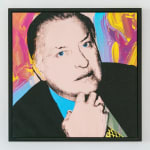
Andy Warhol 1928-1987
Portrait of Charles Ireland, 1979
Acrylic and silkscreen ink on canvas
101.6 x 101.6 cm. (40 x 40 in.)
Copyright The Artist
